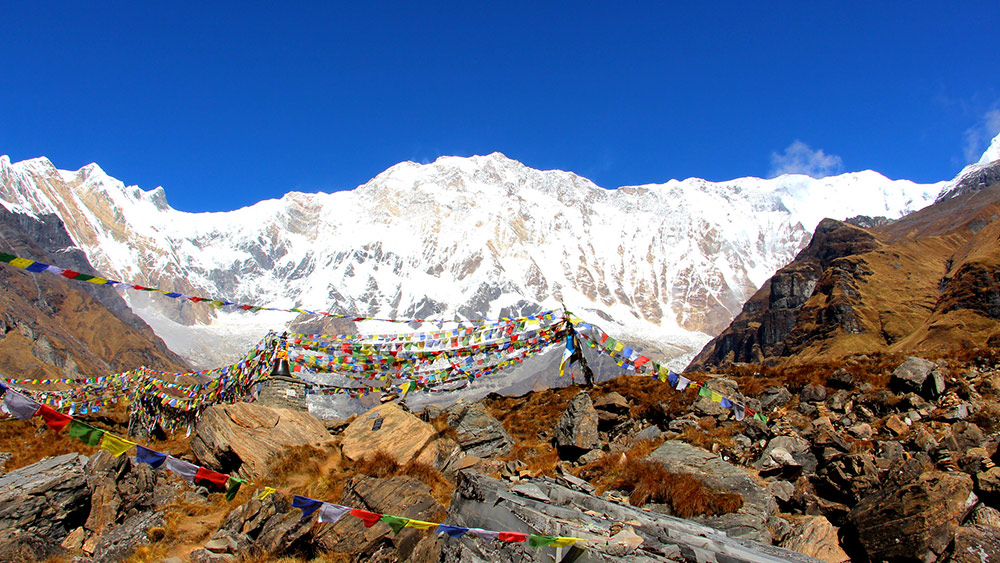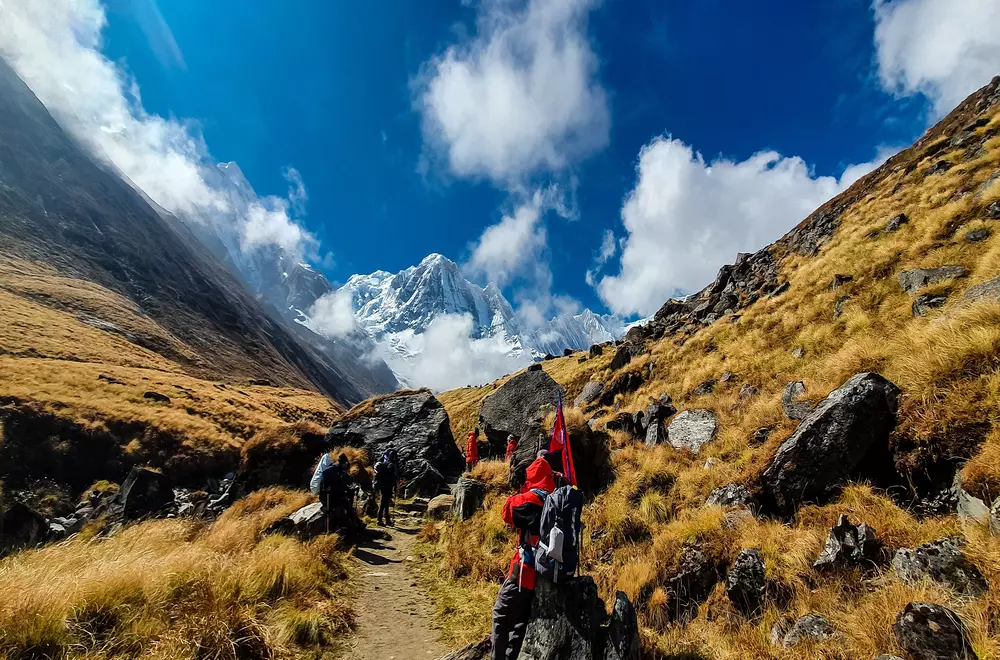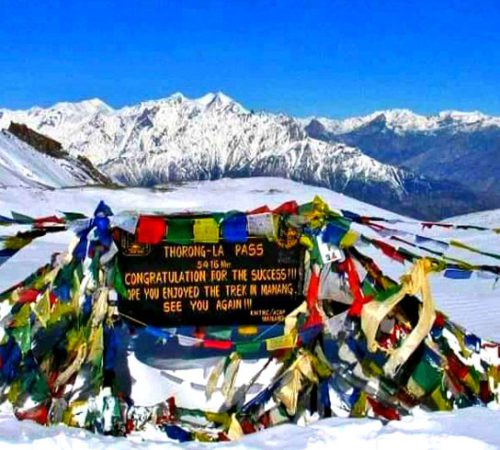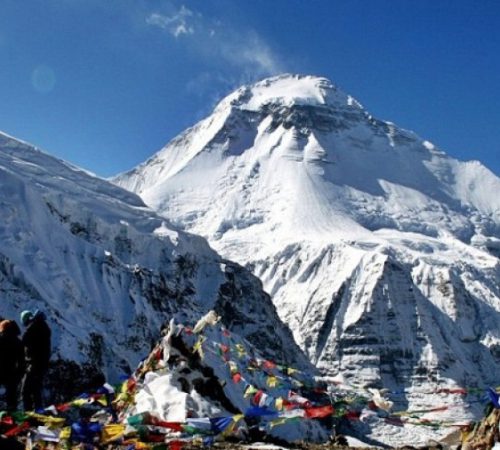Trip Facts
-
Duration
13 Days
-
Trip Start and End
Kathmandu/ Kathmandu
-
Difficulty Level
Moderate
-
Trip Area
Annapurna Region
-
Maximum Altitude
4130m/13,549.87ft - ABC
-
Best Season
Summer & Spring
-
Meals
Full Board
-
Accommodation
Teahouse/Lodge
-
Transportation
Flight, and Jeep or Bus
Highlights
- Scenic Drive from Kathmandu to Pokhara
- Pokhara
- Ghorepani and Poon Hill
- Stunning Sunrises and Sunsets
- Diverse Landscapes and Flora
- Cultural Experiences
- Chhomrong Village
- Local Cuisine
- Varied Trekking Terrain
- Annapurna Sanctuary
- Machapuchare Base Camp (MBC)
- Annapurna Base Camp (ABC)
- Hot Springs at Jhinu Danda
Trip Overview
The Annapurna Base Camp (ABC) trek is a popular trekking route in Nepal, renowned for its breathtaking scenery, diverse landscapes, and cultural richness. This trek leads adventurers to the base camp of Annapurna I, the tenth highest mountain in the world at 8,091 meters (26,545 feet), offering a unique blend of high mountain vistas and cultural experiences. Starting from the vibrant city of Pokhara, the gateway to the Annapurna region, trekkers journey through lush subtropical forests, terraced fields, and traditional Gurung and Magar villages. The initial days of the trek are characterized by gentle ascents and descents, crossing suspension bridges over rushing rivers and walking through dense rhododendron forests that burst into color during the spring season. As the trail ascends, the landscape changes dramatically. The forests give way to alpine meadows, and the air becomes thinner and cooler. The villages along the route, such as Chomrong, Dovan, and Deurali, offer warm hospitality and a glimpse into the local way of life. Trekkers can enjoy the local cuisine, including the famous dal bhat (lentil soup with rice), and observe traditional farming practices.
One of the key highlights of the ABC trek is the Machapuchare Base Camp (MBC), situated at 3,700 meters (12,139 feet). This spot offers stunning views of Machapuchare (Fishtail Mountain), a sacred peak revered by the locals and off-limits to climbers. The trek from MBC to Annapurna Base Camp is a spectacular ascent through a glacial moraine, surrounded by towering peaks and often bathed in the golden light of sunrise or sunset. Reaching Annapurna Base Camp at 4,130 meters (13,549 feet) is an exhilarating experience. The base camp is set in a natural amphitheater, encircled by some of the most magnificent peaks in the Himalayas, including Annapurna I, Annapurna South, Hiunchuli, and Machapuchare. The panoramic views of these towering giants, especially during the early morning hours, are awe-inspiring and offer ample opportunities for photography and reflection. The descent follows the same route back to Pokhara, allowing trekkers to revisit and savor the beauty of the landscapes and villages. The return journey often feels different, with a sense of achievement and the memories of the majestic mountains providing a fresh perspective. The trek concludes in Pokhara, where trekkers can relax by the serene Phewa Lake and explore the vibrant Lakeside area.
The Annapurna Base Camp trek is accessible yet challenging enough to provide a sense of adventure. It offers a well-rounded experience of the Himalayas, combining natural beauty, cultural insights, and the thrill of reaching the base camp of one of the world's highest peaks. Whether you are a seasoned trekker or a first-time visitor to Nepal, the ABC trek promises a memorable journey through some of the most stunning scenery on Earth.
Daily Itinerary
+ Show More• Altitude: 1,400m/4,593ft
• Activities: Rest, explore Kathmandu, prepare for the trek
Cost Includes
- All land transportation and domestic flights as required for the trip itinerary
- Pick-ups and Drop-offs in a private vehicle at the airport (Arrival & Departure)
- Hotel Accommodations (Bed & Breakfast) in the city
- 3-course meal (Breakfast, Lunch, & Dinner) during the entire trek
- Accommodations in teahouses/guesthouses/lodges.
- Necessary trek permits, national parks, and restricted areas entrance fees
- First-aid Medical Kits
- Experienced and government license holder English-speaking trekking guides
- Porters (2 trekkers: 1 porter)
- Allowances for crew staff including insurance on medical grounds
- All government taxes, official charges
Cost Excludes
- International Airfare
- Nepal Entry Visa Fees
- Airport taxes at the time of departure
- Personal Expenses
- Additional charges in the tea/guesthouses (Wi-Fi, electricity charge, hot shower, laundry, boiled water)
- Meals (Lunch & Dinner) in Kathmandu
- Extra night’s stay accommodation and meals in Kathmandu
- All kinds of Alcoholic & Non-alcoholic Beverages, Mineral Water
- Personal Trekking Gears
- Emergency Rescue cost & Travel Insurance cost
- Tips to the supporting crew members (guides, porters, drivers) after the trip completion
- Unforeseen events
Departures Dates
| Start Date | End Date | Price (USD) | Availability | Booking |
|---|
Guidelines/Information
Accommodation
Teahouses/Guesthouses/Lodges are means of accommodation in the Annapurna Region. The hotel is the accommodation in the city. Teahouses are generally simple and comfortable with basic facilities. But, trekkers must pay additional charges for the use of Wi-Fi, electronic device charges, hot water buckets, laundry, and boiled water.
Meals
Only Breakfast is provided during the hotel stay in the city. The full 3-course meal (breakfast, lunch, and dinner) is provided during the trek. The meals are basic but healthy, hygienic, and appropriate for the trekkers’ health. Fresh homegrown vegetables are served in most parts of the trek. Nepali Dal-Bhat is the main dish served with vegetable curry, and pickles which is a good source of energy for the trekkers. The meal varieties are fewer during the trek. Besides Dal-Bhat, noodles, soups, hot drinks, roti, and fresh curries are served.
Drinking water
Water drinking during the trek is very essential as it keeps the body hydrated. In the Annapurna region, drinking water is available everywhere. One can purchase a mineral water bottle or fill up the water at the teahouses. If one needs boiled water, pay an additional charge. But, remember to carry water purifying solutions/kits for safe water treatment and to stay safe & healthy. Also, carry your personal water bottle to minimize the risk of using plastic bottles and keep the environment safe.
Communication
Mobile networks and internet facilities are easily accessible in the lower regions of the Annapurna region. The network connections are fair and stable. One can pay an additional charge to use the internet facilities in the lower region. But, in the higher regions of the Annapurna, the connections are unstable or not at all. Also, for using the phone and internet, one can purchase a local Sim and use the internet facility from the data packs.
Required Permits
- ACAP permit cost charge: NPR 3000 (Foreigners), NPR 1000 (SAARC)
- TIMS permit cost charge: NPR 2000 (Foreigners), NPR 600 (SAARC)
Travel Insurance
Travel Insurance is compulsory while trekking in Nepal. It acts as a safety tool that prevents unforeseen and unwanted events during the travel journey. One must get travel insurance from a trusted insurance company. It must cover all emergencies, flight cancelations, loss/theft of luggage, altitude over 3000m, evacuations, and medical difficulties. Travel Insurance makes your journey stress-free.
Safety and our guides
The client’s safety is our topmost priority. So, when it comes to safety one can 100% trust us. Our guides are certified and have years of experience in this field. They are aware of the technical difficulties, altitude sickness, and health of the trekkers in the mountains. Thus, they are fully prepared and always carry necessary medical kits, safety tools, and experts in safety performances. From day 1 to the end of the trek, the client’s safety is taken into consideration and kept as a high priority. Therefore, all the program itineraries are carefully planned and scheduled with proper acclimatization and rest days to prevent altitude sickness and adapt to the higher altitude. We are available 24/7 at your service. Hence, feel free to ask queries and share your thoughts.
Best time for Annapurna Region Trek
All seasons have their beauty. But, when it comes to trekking in the Annapurna region, Spring and Autumn seasons are termed best. These two seasons are the best time to explore as the weather is clear, the days are bright, and trekking trails are easy to walk. During Spring, witness the blossoming seasonal flowers in this region. Spring and Autumn season is followed by the Summer season to trek in the Annapurna region. Winter and Rainy seasons are riskier due to muddy, slippery, and snowy trails. The weather is also uncertain and the chances of the temperature fluctuating are high making it cold for the trekkers. It is advisable to properly plan before trekking in the rainy and winter seasons in the Annapurna region.
Annapurna Region Trek Difficulty
Annapurna Region’s Trek is easy to moderately challenging depending on the trek duration, elevation, and trail structure. The trek trails may include several steep ascends, and descends, rugged trails, and high elevations. The trek difficulty is the part of the trekking journey which is unavoidable. But, to minimize the difficulty during the trek, trekkers must be physically and mentally fit before the start of the trek. Trekkers can take part in physical training, exercises, short day hikes, cardiovascular exercises, and healthy diets. Take essential health tests and keep yourself motivated before the trekking journey. Here in Nepal, our assistance is always there throughout the trekking journey.
Altitude Sickness and Acclimatization
Altitude sickness is common at an altitude above 3000m. Here in Nepal, during trekking, altitude sickness chances are high. The high elevation, the weather, and the temperature play a key role. Thus, to prevent altitude sickness acclimatization is quintessential. Thus, the acclimatization rest days are carefully scheduled to adapt to the surroundings. All age groups and even healthy people can suffer from altitude sickness. But, no need to panic as its symptoms and precautionary advice is given below:
Altitude Sickness Symptoms
The symptoms of altitude sickness are primary at the initial stage and get extreme if primary symptoms are not taken into consideration.
Primary symptoms: Headache, vomiting, breathlessness, loss of appetite & sleep, tiredness, vertigo
Extreme symptoms: primary symptoms along with delusions & unconsciousness
Precautionary Advice
- Inform the guide immediately
- Stretch the body and do warm up before the start of the trekking journey
- Keep yourself hydrated by drinking water at regular intervals
- Urinate frequently throughout the journey
- Keep it slow and steady
- Take proper rest and sleep
- Avoid taking salty and unhygienic foods
- Avoid consuming alcohol, and smoking
- If it feels uneasy or difficult, immediately descend
- Consult a guide to take a medicine
Porter Luggage limitation
One porter is assigned to carry the luggage of two trekkers. The luggage limitation is a maximum of 15 kg per trekker.
Equipment checklist
Essential Documents: Passport, Travel Permits, Visa Photocopy, Passport size photos
Food: Light snacks, Energy bars, and drink mix
Shoes: Camp shoes, Pair of hiking boots, Rubber sandals
Clothes: Windcheater jacket, Thermals, Insulating Down Jacket, Fleece, Long sleeve shirts, Gloves, Towels, Inner garments, Trekking pants, Trousers, Shorts, Socks, Raincoat, Balaclava, Bandana, Gaiters
Accessories: Sunglasses, Hats/Caps, Sunscreen, Lip Balm, Water bottles, Pocket Knife, Solar chargers, Batteries, Head Lamps, Torch, Umbrella, Sewing kit, Water Purifying solution kits, reusable bags to deposit waste, and separate clean/dirty clothes
Equipment & Gears: Warm Sleeping bags, Map, Trekking poles, Duffel bag, Carabiners, Crampons, Tapes/Slings, Ice Screws, Ice Ax, Harness, Rope, Spikes
Medicine: First-Aid Kit, Altitude sickness medicines, Insect repellents, Blister kits, Approved medicines
Rainy season: Waterproof clothes, boots, Raincoat, Anti-leech socks
Winter Season: Light woolen clothing items
Personal Hygiene Kit: Hand sanitizer, wet wipes, napkins, sachet shampoo, moisturizer, hand wash/soaps, toothbrush, toothpaste, comb/brush, razor, and for ladies (menstrual kits)
Note: One can customize the above list. Only bring necessary items from the provided list from your home or one can rent or purchase here in Nepal.
FAQs
Spring (March to May) and Autumn (September to November) are the best times for the ABC trek. During these periods, the weather is generally clear, and temperatures are moderate, offering excellent views of the mountains and pleasant trekking conditions.
The trek involves significant elevation changes, with some steep ascents and descents, but it is manageable for most people with a reasonable level of fitness. No technical climbing skills are required.
Annapurna Conservation Area Permit (ACAP): Required for entry into the Annapurna Conservation Area.
Trekkers’ Information Management System (TIMS) Card: Required for trekking in the Annapurna region.
The trek typically takes 10-14 days, depending on the specific itinerary and pace. This includes time for acclimatization and exploration.
Essentials: Good quality trekking boots, warm clothing (layers), rain gear, sleeping bag, trekking poles, first aid kit, water purification tablets, sun protection (hat, sunglasses, sunscreen), snacks, and personal hygiene items.
Optional: Camera, power bank, book/journal, and light entertainment for evenings.
The trek offers teahouse accommodation, which provides basic lodging and meals. Rooms are usually shared with basic amenities.
Teahouses offer a variety of meals, including traditional Nepali dishes (like dal bhat), as well as international options such as pasta, pancakes, soups, and more. It is advisable to stick to vegetarian options to avoid foodborne illnesses.
Wi-Fi: Available at most teahouses, but the connection may be slow and there is usually a fee.
Charging: Charging facilities are available, but there may be a fee. It’s a good idea to bring a power bank.
Acclimatization: The trek involves significant altitude gain, so proper acclimatization is crucial. Take it slow, stay hydrated, and pay attention to your body.
Symptoms: Headache, nausea, dizziness, shortness of breath. If symptoms worsen, descend to a lower altitude and seek medical help if necessary.
There are no ATMs on the trekking route. It is important to carry sufficient cash (Nepalese Rupees) for expenses during the trek.
Yes, travel insurance is highly recommended. Ensure your policy covers high-altitude trekking (up to 4,130 meters) and includes emergency evacuation.






